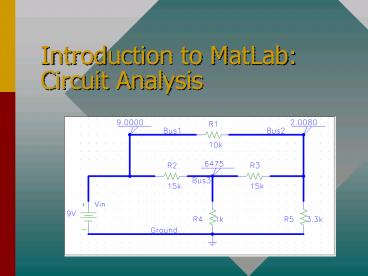Introduction%20to%20MatLab:%20Circuit%20Analysis - PowerPoint PPT Presentation
Title:
Introduction%20to%20MatLab:%20Circuit%20Analysis
Description:
... Resistors A constriction in the flow of current Analogous to a small orifice in a water pipe, it ... usually electrical ground. ... Introduction to ... – PowerPoint PPT presentation
Number of Views:335
Avg rating:3.0/5.0
Title: Introduction%20to%20MatLab:%20Circuit%20Analysis
1
Introduction to MatLab Circuit Analysis
2
Introduction
- MatLab can be a useful tool in many applications.
- We will learn how to analyze a simple electrical
circuit, set the problem up as N equations in N
unknowns, and transform the equations into a
matrix formulation that MatLab can solve.
3
Topics
- Electrical Devices.
- Kirchhoffs Laws.
- Analyzing a Resistor Network.
- Inverting Matrices.
- A MatLab Solution.
4
Electrical Devices
- Voltage and Current.
- Sources.
- Resistors Ohms Law.
- Capacitors Charge Storage.
- Inductors Current Storage.
5
Voltage and Current
- Voltage - the force that pushes electrical
current around a circuit. (Sometimes called
potential as in potential energy.) - Current - the flow of electrical charge through a
conductor. (Electrons flow backwards) - Conductor - the pipe through which an
electrical current flows.
6
Sources
- Voltage Source Fixed Voltage waveform
- Direct Current A battery
- Alternating Current A generator (sine waves)
- Current Source Fixed current waveform (AC or DC)
7
Resistors
- A constriction in the flow of current
- Analogous to a small orifice in a water pipe, it
takes a high pressure (voltage) to force a flow
of water (current) through the resistance. - Ohms LawVIR
8
Resistor Color Codes
- First two stripes Digits
- Third stripe Power of 10
- Fourth stripe Precision (none - 20, silver
- 10, gold - 5)
5 - Green 6 - Blue 7 - Violet 8 - Gray 9 - White
- 0 - Black
- 1 - Brown
- 2 - Red
- 3 - Orange
- 4 - Yellow
9
Capacitors
- A charge storage device
- Analogous to a water tank that is filled from the
bottom. As the water level rises (charge divided
by the cross sectional area capacitance), the
pressure (voltage) rises. - Capacitor LawVQ/C
10
Inductors
- A current storage device
- Analogous to the inertial effect of the flow of a
fluid. The inductance is the mass that is
moving. - Inductor Law VLdI/dt (dI/dt is the rate of
change in the current. This is
analogous to velocity.)
11
Kirchhoffs Laws
- Conservation of CurrentThe sum of all currents
into a node equals zero. - Loop LawThe sum of all voltages around a loop
equals zero.
12
A Resistor Network
13
Measurements
- Multimeter (Analog and Digital)
- Voltage - measured relative to a reference,
usually electrical ground. - Resistance - meter puts a small current through
the resistor and uses Ohms law. - Current - careful, the meter can be destroyed by
an over-current.
14
Loop Equations
- Establish Independent Loop Currents
- Write Equation for Each Loop
- Determine voltages in terms of the loop currents.
- Sum to zero
- (note Alternative, use a set of Node
equations)
15
Our Circuit First Step
- 9v 15k(I1-I2) 1k(I1-I3)
- 0 10kI2 15k(I2-I1) 15k(I2-I3)
- 0 1k(I3-I1) 15k(I3-I2) 3.3kI3
16
Our Circuit Collecting Terms
- 9v 16kI1 - 15kI2 - 1kI3
- 0 -15kI1 40kI2 - 15kI3
- 0 -1kI1 - 15kI2 19.3kI3
17
Vectorizing N Equations
- Rewrite, ordering variables
- Formulate equivalent as an input column vector
equals a coefficient matrix times an unknowns
vector - Solution pre-multiply both sides by the inverse
of the coefficient matrix.
18
Our Circuit Vector Equation
- 9v 16k -15k -1k I1
- 0 -15k 40k -15k I2
- 0 -1k -15k 19.3k I3
19
Inverting Matrices
- The inverse of a square matrix is that matrix
which, when multiplied by the original matrix
yields the Identity matrix - In MatLab use inv().
20
Our Circuit Inverse Matrix
- I1 0.1396 0.0777 0.0676 9
- I2 0.0777 0.0785 0.0651 0 10-3
- I3 0.0676 0.0651 0.1059 0
21
Our Circuit Currents
- I1 1.256
- I2 0.6992 10-3 amps
- I3 0.6085
22
Intro To PSpice
- Originally from Microsim, now part of OrCad.
- Demo/student CDROM is free at www.orcad.com,
current version is 9.2, Limited to small circuits
and part library. - Graphical simulation of circuits and automated
Printed Circuit board layout.
23
Introduction to MatLab Circuit Analysis
0.6992 ma
0.6085 ma
1.256 ma































